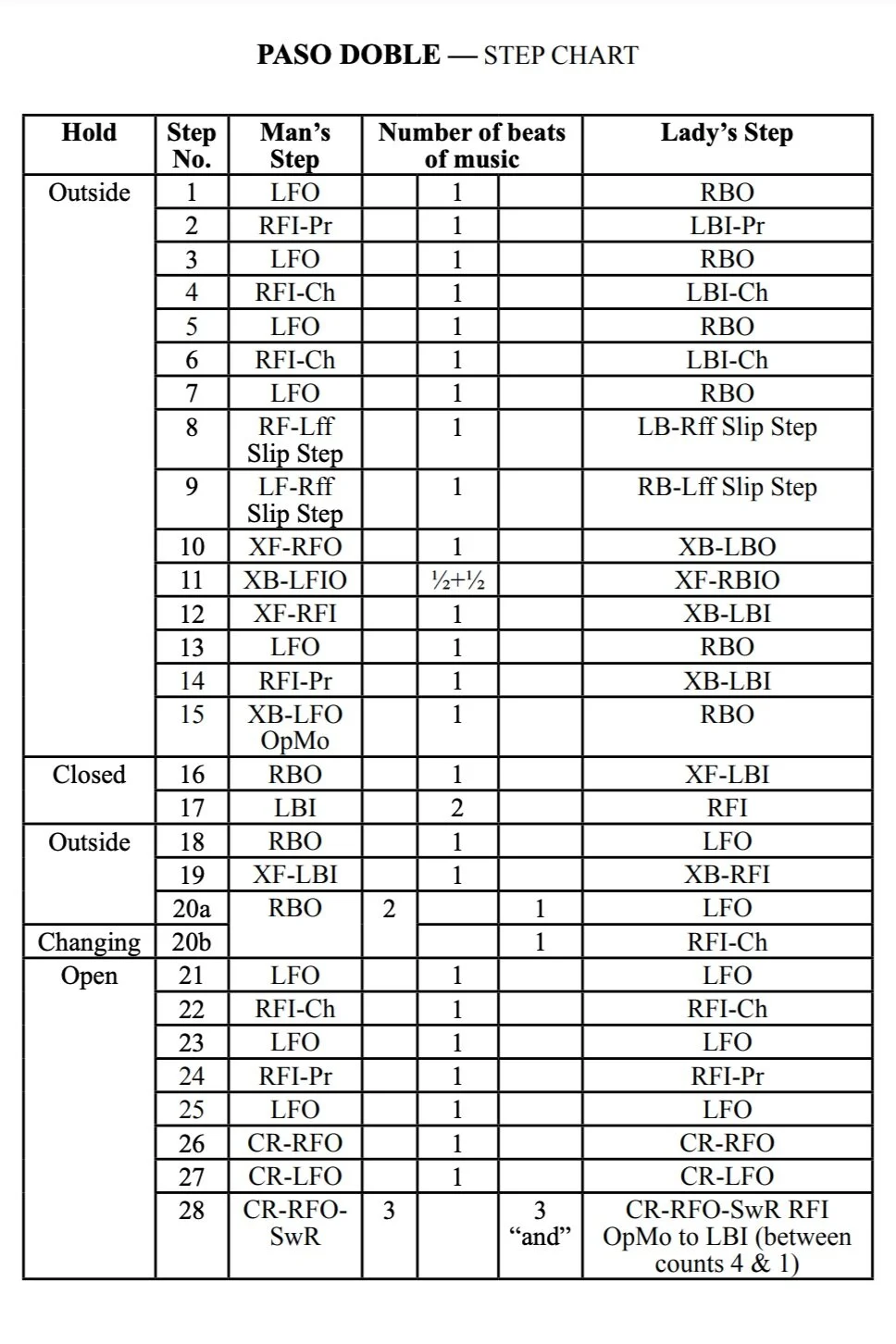PASO DOBLE
The Paso Doble is a dramatic and powerful Spanish dance requiring good body control and precise footwork. It can be expressed in terms of its origins from the music of bull fighting or in Flamenco style.
Steps 1 to 15 are skated in outside hold with the lady to the man’s right. The dance starts with a progressive sequence followed by two chassé sequences. Steps 8 and 9 are most unusual slip steps (sometimes called “slide steps”) for both the lady (skating backward) and the man (skating forward). They are skated on the fat with both blades on the ice and with the free foot sliding closely past the skating foot to full extension. There are two optional ways to perform these steps: one option is to skate with the knee(s) of the weight bearing leg(s) bent as they slide across the ice, and the other option is to skate with the knee(s) of both of the weight bearing legs straight.
On Step 10, the free foot must be lifted distinctly from the ice. The following change of edge on Step 11 should be boldly skated to produce a pronounced outward bulge of the pattern. The man crosses in front on Step 12, then skates a progressive sequence leading into a cross behind open mohawk. The lady skates a series of cross steps to coordinate with his. After the man’s mohawk, the partners assume closed hold.
Step 17 is the first two-beat edge of the dance. The man extends his free leg in front, and the lady extends her free leg behind. The man then skates a backward edge, a front cross step, then a two-beat back edge before stepping forward into open hold for chassé and progressive sequences. Meanwhile, his partner skates a cross behind chassé followed by two chassés and a progressive sequence. The first of her two chassés is skated while the man pauses two beats on Step 20. Steps 21 to 24 are performed together. Care must be taken to ensure that the partners remain in closed hold to the end of Step 20.
Probably the most difficult portion of the dance is the cross rolling movement on Steps 26 to 28. The deeper these outside edges are the better, which necessitates very supple knee action owing to the fast tempo of the dance. On the last cross roll the free legs are swung to the front, and both partners remain on the right forward outside edge. Then, only as they bring their free legs back to the heel (for the man to prepare to push, and the lady to execute a quick open swing mohawk on the “and” between counts four and one), they change to a very short RFI edge. This places her in outside hold again for the restart of the dance.
The overall pattern of the Paso Doble is approximately elliptical, distorted here and there by outward bulges. The opening progressive is on a curve, but the next few steps are rather straight. The change of edge produces an outward bulge followed by Steps 12 to 25 that form a curve. The cross rolls cause a deviation in the pattern, and there is a final bulge before the restart of the dance.
MUSIC RHYTHM: Paso Doble 2/4
TEMPO: 56 two-beat measures per minute; 112 beats per minute
ISU MUSIC INTRODUCTION: 32 beats, 17.1 seconds
PATTERN-TIMING: 1 = :17; 2 = :34; 3 = :51; 4 = 1:09
DURATION: Test 2 = :34 Solo after partnering 2 = :34 Competition 3 = :51 Adult Competition 2 = :34
SKATER’S CHOICE TIMING: See Skater’s Choice Pattern Dance Timing Chart on usfgureskating.org under the “Technical Info” link
PATTERN: Optional
TEST: Pre-gold
INVENTORS: Reginald J. Wilkie and Daphne B. Wallis
FIRST PERFORMED: Westminster Ice Rink, London, England, 1938
Paso Doble — Step Chart - 2019-20 U.S. Figure Skating Rulebook
PASO DOBLE-MAN — OPTIONAL PATTERN DANCE
Paso Doble - MAN — Optional Pattern Dance - 2019-20 U.S. Figure Skating Rulebook
PASO DOBLE-LADY — OPTIONAL PATTERN DANCE
PASO DOBLE-LADY — OPTIONAL PATTERN DANCE - 2019-20 U.S. Figure Skating Rulebook


